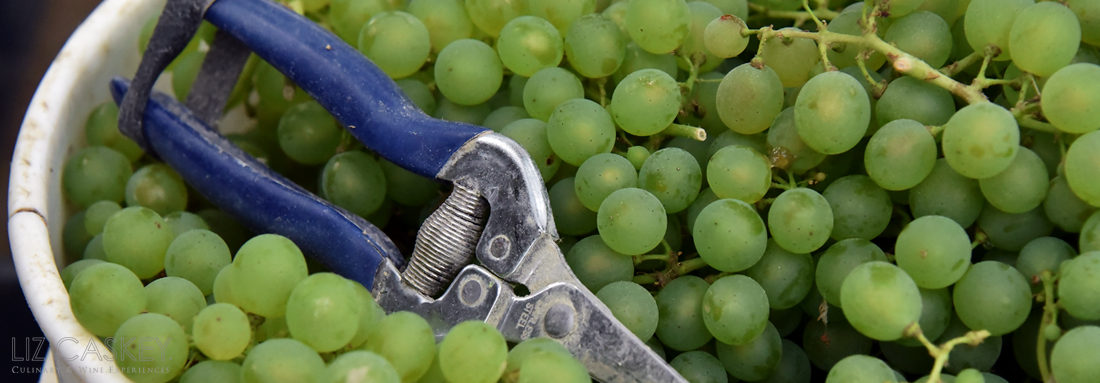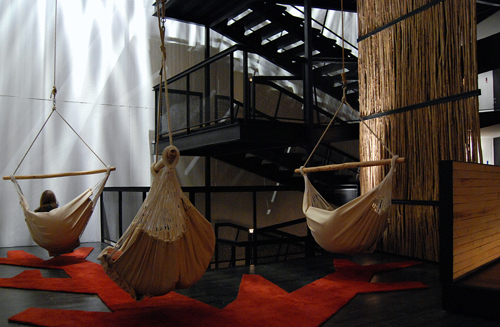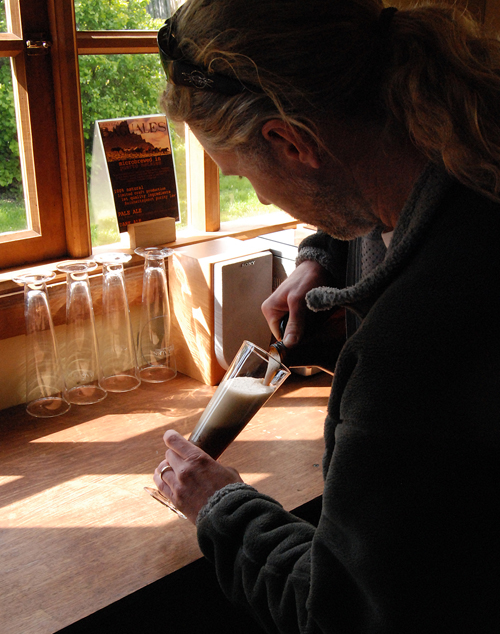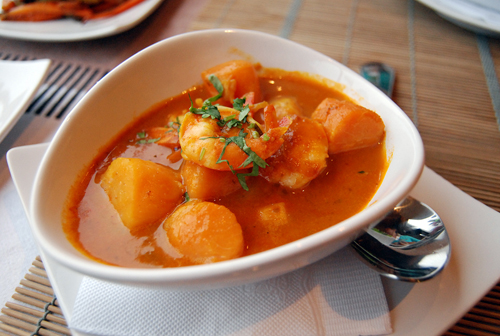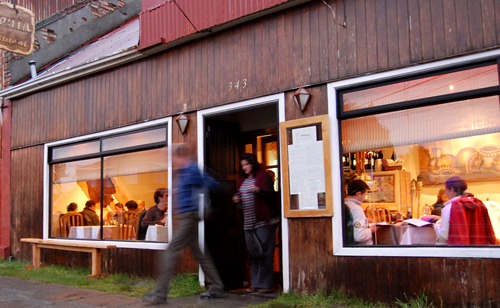The wind is howling. Gale force gusts moan and it sounds like a stampede on the roof. I peer through our hotel room window overlooking the icy Fjord of Last Hope. White-capped swells crash towards the rocky shore, jostling the fishing boats rhythmically. Street signs twist sideways below and trees bend gracefully with the wind. Welcome to Puerto Natales. My husband and I have just arrived in the far-flung province of Magallanes, at the end of the South American continent and Chile. It’s quite the journey to get here: four hours flying from Santiago followed by a scenic three-hour drive from Punta Arenas, the capital of the region. We crossed the windblown estepa, grasslands, dotted only by coirón bushes and thousands of sheep grazing.
The sunlight disappears behind a fast-moving black cloud causing an impromptu snow storm. Puerto Natales really seems like the most peculiar of “foodie” destinations. How could a burgeoning gastronomic culture thrive in such infamously inclement weather? What about the difficult access by ship for foodstuffs? Why would locals stray beyond the meat and potatoes roots of the region that reflects the Scottish and Germanic heritage? Why now, why here? Who was behind it? Our short stay is to answer that while eating our way through town. We would work off the calories by day in the stunning natural settings surrounding “Natales”, as the locals calls it.
Puerto Natales is a rambling town of 20,000 residents, founded in 1911 by Scottish and German immigrants who came to export lamb’s meat and wool to Europe. Today, thousands of international travelers come through the town’s tidy streets from October to April en route to the one of Patagonia’s biggest attractions: Torres del Paine National Park. An UNESCO World Biosphere Reserve with over 450,000 acres, and only a short 1.5 hour bus ride from Puerto Natales, the park boasts tranquil lakes, ancient glaciers, miles of rolling grasslands, and the serrated peaks of Paine and its granite towers.
Beyond the park though, the attraction is clear. Life feels far away here. Slower, simpler, safer, purer. A dream landscape for adventure enthusiasts full of fjords, glaciers, rivers, and mountains to trek, kayak, climb, gallop. An outdoorsy paradise not unlike Alaska. Visitors come—and never want to leave. This all started with expats and dislocated Santiaguinos who began to set up shop. The little frontier town evolved with a cosmopolitan vibe.
Our base for exploring is Indigo, the only boutique luxury hotel in town with a coveted location on the waterfront. Indigo is attractive with clean lines whispering of Scandinavian design. A container-esque structure rises vertically with sweeping views of the sound. The modern part of the hotel melds into the original wooden home from the early 20th century, which was Hernan Jofré’s first hostel and now home to their gourmet restaurant, Mama Rosa. Indigo is both a testament of both the regional boom and food revolution happening in Puerto Natales. Over and over again we would come to discover these projects belonging to young 30-something owners and couples. In this case, Indigo is the vision of three young owners: Chilean climber Hernán Jofré, the Spanish Ana Ibañéz, and French Olivier Potart. The hotel exudes their onda, vibe. Hip, cozy, comfortable, indulgent in food and their top-level sauna and spa, it is a modern refuge from the elements,
Cristián Leal is the charming manager of Mama Rosa, who also in his mid-30s traded in Santiago for Puerto Natales—and never looked back. He’s offered to take us to visit Señora Rosalva, the engine behind the food movement. She’s responsable for all the fresh, organic produce consumed in Puerto Natales. An older woman with a weathered smile and motherly kindness, her pet sheep shyly accompany us as we poke around the tarped green houses in a bone-chilling rain. Also an “immigrant” to Natales, she arrived from Chiloé twenty years ago to start her organic business on a shoestring with a small grant from the government.
“I had no idea what any of these products were”, she says, pointing to baby arugula. Today, along with 30 co-op workers, she grows baby arugula, several types of lettuce, cherry tomatoes, chard, native potatoes, carrots, sweet and chili peppers. Inside the greenhouses, there’s enough warmth for these delicate plants to survive the harsh Patagonian climate. As tourism surged, so did demand. She let the chefs and businesses guide her as to what they needed. She’s now the preferred supplier of fresh produce in Natales. We would savor her amazing vegetables during our entire stay, and later regret not being even able to get this quality in Santiago!
Frozen solid, we pop in to Patagonia Dulce, a local chocolate-shop-cum-café with inviting picture windows. The sign on the door states, “We attend to chocolaholic emergencies”. I am in the right place. The interior is impregnated by the sweet, seductive scent of melted chocolate. Arnaldo Alarcón and Maritza Bahamondes, the owners, offer thirty-odd ways to tempt you with chocolate in liquid or solid creations. Maritza proudly makes the gooiest brownie in town and hand-cut homemade chocolate tinged with nuts. The submarino with steamed fresh milk and melted dark chocolate and “like water for chocolate”, a light, flavorful hot chocolate made with hot water and cinnamon, was exactly what we needed to defrost.
We dine at Mesita Grande, one of the first restaurants in the current boom now five years and counting. A chill pizza parlor on a scenic corner of the town’s plaza, the cherry red facade was built in 1916 and sits next to the old school parrilla, Asador Patagónico, manned by chef Fernando Luksic in the old apothecary serving lots of grilled meats. Just next door is El Living, started by British expat couple Anne Patterson and Jeremy Salter, the first and only vegetarian café in town with a low key vibe serving up from hummus to burritos and abundant salads. Inside Mesita Grande, there’s only one long wooden table. The scene is buzzing as the wood-burning brick oven churns out thin-crust pizza at lightening speed, while young Max Salas, the owner, mans the antique cash register. The mesita grande pizza is an unusual combination topped with lamb, onions, and chilies. The matavampiros, Vampire Killer, is laced with buttery, roasted garlic. I love Sandra’s favorite, named after Max’s wife, strewn with proscuitto, arugula, and parmesan. We down the hoppy Pale Ale from Cervecería Baguales, Natales first microbrewery started by California native Chad Horton who came to climb in the park and fell in love. With the pure water, he saw the opportunity to make a high quality beer for the town, which is on tap in nearly every restaurant.
The next day is cloudless. We journey into the Torres del Paine park for a “show” of jagged mountains, azure glaciers, lakes from emerald to deep blue. It looks like nature on steroids. With the spring, the grasslands and hills are verdant, strewn with yellow and red wild flowers. We can see the Paine Massif almost from Puerto Natales as we depart and as we approach the park entrance at Laguna Amarga, we catch glimpses of the famous torres, three granite rock towers. We are lucky to have this day, even as the wind howls. Pehoé lake is ocean-like with two meter swells wetting the roadways. Condors circle overhead. I keep pinching myself to make sure it’s not a dream. It’s not.
That night back in Puerto Natales, we have a date at Afrigonia, which is one my favorite restaurants in Chile. Kamal Nawaz, a native of Zambia, married the Chilean Nathalie Raffer, whose parents lived in Africa working in copper. They met, fell in love, eloped, and had a daughter. They relocated only three years ago to Puerto Natales where Kawal sought to fuse the flavors of his homeland, Africa, with Patagonia. Afrigonia was born. Adorned with warm, natural tones, wood-carved masks, and animal skins, Kamal transforms the native seafood, lamb, and Rosalva’s produce into highly flavored creative dishes. We savor a salmon ceviche laced with lime juice and coconut milk; fresh king crab salad with a kiwi and calafate, native berry, sauce. Diver-sized scallops from the Fjord were succulent in a sweet yet piquant curry. The seared lamb chops with mint sauce are a revelation. And lots of vibrant greens from Rosalva in their salads. Simple. Delicious. Driven by the local ingredients.
The next morning we set off with Estancia Travel to kayak the calm waters of the Eberhard fjord. We push off from the first settlement in the region, Puerto Prat, and paddle upstream past black-necked swans towards Puerto Consuelo, an old cattle farm. The wind picks up and the waves push us back to port. After a traditional spitted lamb barbeque, we saddle up on the meticulously maintained horses for a leisurely ride around the estancia property. High from the hills, we look down upon the serrated Fjord, once a glacier, and further on towards the Torres del Paine’s Macizo Paine.
Our last night in town we reserve for Mama Rosa at Indigo. Mama Rosa has the best view in town of the Last Hope Sound with lofty ceilings and a modern look peppered with funky antiques like a cherry-red wood burning stove. We start with their signature pisco sours Calafate Berry, a play on the beloved Cosmo and the Nippon with green tea and mint. As we nibble on a delicious steak tartare and Nikkei ceviche made with salmon and Asian accents, a saxophone plays soft jazz. Their superstar dishes like the king crab-filled ravioli and a perfectly seared congrio, conger eel, on top of vegetable-laden quinoa deliver. The dessert of is a subtle rosemary pannacotta with strawberry glaze. Memorable.
Why Natales has become a roaring gastronomic pole is now clear. Young owners on-site live their passion: good food. They combine this with the best fresh ingredients from the sea, land, Señora Rosalva’s produce, the stunning nature, and a high quality of life. However, what most struck me was the attitude. Somehow, every place made a simple drink or meal feel special. Homemade. Infused with lots of cariño. Food is so telling of a place’s history and people. It is inspiring to experience how this town of immigrants, 100 years after being founded, is once again forging a new gastronomic history with a new wave of pioneers. A true foodie frontier.
Published in LAN Airlines, IN Magazine, December 2010.
Datos:
Hotel Indigo
Ladrerillos #105
(61) 413 609
www.indigopatagonia.com
Estancia Travel
Offering horseback trips from a day up to a week of the region’s working estancias.
(61) 412 221
Afrigonia
Eberhard #343
(61) 415 285
Asador Patagónico
Arturo Prat #158
(61) 413 553
Cervecería Baguales
Barros Arana #146
(61) 613 648
www.cervezabaguales.cl
El Living
Arturo Prat #156
(61) 411 140
www.el-living.com
Mama Rosa
Ladrerillos #105
(61) 413 609
www.indigopatagonia.com
Mesita Grande
Arturo Prat #196
(61) 411 571
www.mesitagrande.cl
Patagonia Dulce
Barros Arana #233
(61) 415 285
www.patagoniadulce.cl
